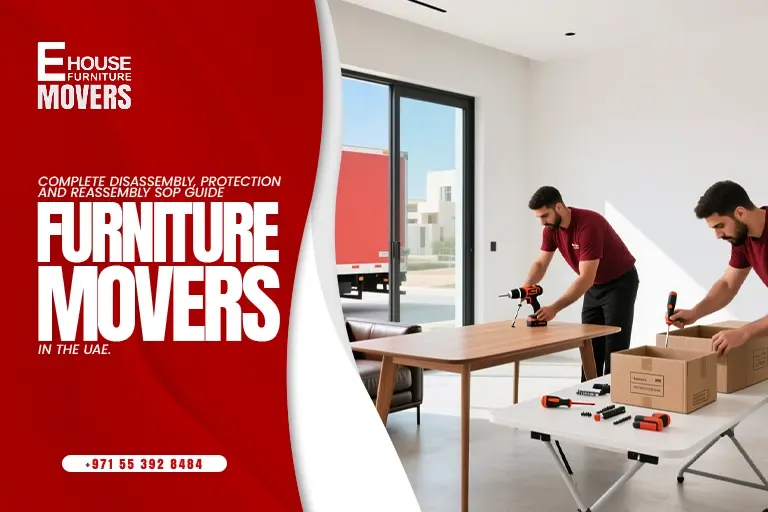This informational guide sets out a practical, evidence-based SOP for moving large furniture in the UAE—especially beds, wardrobes, and modular kitchens—covering toolkits, fasteners, photo documentation, packing materials, truck securement, building/community compliance, and reassembly QA. All key claims are supported by verified sources; links are provided via natural anchor text. Internal links are included as anchor texts you can map to EHouse Movers pages.
Why does a formal SOP matter in the UAE?
A structured disassembly-protection-reassembly process reduces damage, prevents lost hardware, and keeps moves compliant with UAE building/community access rules and time windows. In Dubai’s master-planned communities (e.g., Emirates Living), a move-in permit is mandatory and security can deny access without one; high-rises typically require service-elevator bookings in set time slots.
Local conditions intensify risk: extreme summer heat and high humidity can affect adhesives, tapes, and finishes; dust exposure is common; and long hauls (e.g., Dubai↔Abu Dhabi) add vibration loads. Dubai’s climate routinely exceeds 43 °C in July–August and coastal humidity often reaches 90%, so moisture-resistant packing and fast, clean handling become critical.
Step 1 — Disassembly: what to remove, how to document, which tools to use
1.1 What typically gets dismantled?
- Beds: headboard, footboard, side rails, center supports, slats.
- Wardrobes (e.g., PAX): doors, shelves, rails, hinges, back panels (if modular).
- Kitchens: removable doors, drawer boxes/runners, plinths/kickboards, detachable panels; countertop sections only if designed for separation.
Implementation detail: For IKEA PAX-type wardrobes, follow manufacturer instructions—note minimum ceiling height and tip-over safety; reinstallation requires the cabinet to be mounted flush to the wall with correct fixings for local substrates. Use official guides when planning disassembly and reassembly.
Also Read: Furniture Assembly & Disassembly in the UAE: Complete Guide (Bed Frames, Wardrobes, Modular Furniture)
1.2 Photo documentation and part mapping
- Photograph the item from multiple angles before the first screw turns; include hinge positions, runner types, panel order, and hardware orientation.
- Create a labeling scheme (e.g., “Wardrobe-A Left Door / Hinge Bag-A1”).
- Bag and tag: place screws/bolts/washers in zip bags, label them to the exact subassembly, and attach to that panel (tape or stretch-wrap pocket). This reduces reassembly time and prevents “missing screws” failure modes.
(Industry best practices consistently emphasize labeled hardware and taped bags; treat it as non-negotiable.)
1.3 Toolkit list (minimum)
- Hand tools: Phillips/flat screwdrivers, Allen keys, adjustable wrench/spanner, pliers, rubber mallet.
- Power tools: drill/driver with clutch (to avoid over-torque), bit set (Pozidriv for European hardware), countersink.
- Measuring & marking: tape measure, level, painter’s tape, permanent marker.
- Consumables: zip bags, painter’s tape (low-tack for finishes), soft rags, nitrile gloves.
Step 2 — Protection: materials, wrapping sequence, and climate considerations
2.1 Materials and where each fits
- Moving blankets/furniture pads for wood/metal panels (primary abrasion barrier).
- Bubble wrap & foam sheets for mirrors, glass doors, lacquered fronts, stone offcuts.
- Stretch wrap to keep blankets in place and protect from dust/sand ingress.
- Cardboard sheets & corner guards for edges, tops, tabletops, wardrobe doors.
Authoritative guides recommend combining blankets + stretch wrap to stop slippage while avoiding tape residue; glass should be wrapped individually with cushioning; avoid trapping moisture directly under plastic against bare wood/leather—use a soft layer first.
In humid months (April–November, most muggy), finishes and adhesives are more sensitive; staged wrapping (soft layer → barrier → outer wrap) helps prevent sweat-through and print-through on veneers.
2.2 Wrapping sequence (example: 3-door wardrobe)
- Wrap each door panel in a moving blanket; add corner guards; secure with stretch wrap.
- Shelves and rails bundled by size; place hardware bag at the bundle center.
- Cabinet side panels and top/bottom: blanket first, then stretch wrap with 30–50% overlap.
- Mirrors/glass: paper + bubble + cardboard sandwich; mark “GLASS/THIS SIDE UP”.
(For large items, rubber bands or stretch wrap are safer than tape directly on finishes.)
Step 3 — Loading & transport: manual handling and cargo securement
3.1 Manual handling safety (injury prevention)
- Keep the load close to the body, lift with legs, avoid twisting, and survey the route before the lift.
- Use dollies/hand trucks for long carries; team-lift awkward/bulky items; respect individual weight limits.
These are standard controls from NIOSH/OSHA ergonomics and university safety sheets and remain the gold standard for reducing musculoskeletal injuries during moves.
Also Read: Packing & Unpacking Furniture in the UAE: Eco-Friendly Materials & Fragile Item Protection
3.2 Cargo securement in the truck
- Use ratchet straps, load bars, and blocking so wrapped panels cannot shift or fall.
- Heavier components at floor level; do not stack glass/stone under other loads; maintain center of gravity.
The FMCSA cargo securement rules (North American best practice referenced globally) require that articles not shift or fall; apply the same engineering logic to household goods for safe carriage.
If transporting lithium-battery-powered furniture or appliances (e.g., adjustable beds with battery packs): treat batteries under applicable hazardous materials guidance for packaging/marking, and never ship damaged or recalled batteries in standard household-goods cartons.
Step 4 — Building & community compliance (UAE specifics)
4.1 Move-in/Move-out permits and NOCs
- Emirates Living (Emaar): a Move-In Permit (MIP) is required; access is denied without approval. Similar rules apply across many Emaar communities via Emaar One (or ECM portals).
- General Dubai: most managed buildings require a move-in/out permit, service-elevator booking, and loading-bay slot; some developers process this via property/tenant portals (Emaar, Dubai Properties, Nakheel).
4.2 Right-of-Way (ROW) for curbside staging
If your vehicle needs to occupy footpaths/parking/sikkas beside a tower or villa for loading, apply for an RTA Right-of-Way permit; commercial use of ROW in Dubai requires prior approval and fees under the Dubai framework.
4.3 Practical compliance checklist (UAE)
- Obtain community NOC/permit (often 1–3 working days if documents complete).
- Reserve service elevator + loading bay for your time window.
- Arrange RTA ROW permit if curbside/footpath space is needed.
- Keep Ejari/Tenancy and deposit receipts handy if the community requests them at the gate.
Step 5 — Reassembly: order of operations, tolerances, and QA
5.1 General sequence
- Stage parts by room; match labeled hardware bags to each subassembly.
- Build structural frames first (bed frames, wardrobe carcasses, base kitchen units).
- Fit doors/drawers/rails; perform hinge and runner adjustments; level/plumb tall units.
- Torque check: tighten all fasteners; verify no wobble, no racking.
- Safety check for tip-over risks; follow manufacturer anchoring requirements (wardrobes to walls, anti-tip devices).
5.2 Tolerances and alignment (examples)
- Wardrobe doors: even gaps (≈2–3 mm), smooth close without rub.
- Drawer runners: full extension without binding; even front gaps.
- Beds: square the frame (diagonal measurements equal); center support installed; slats seated correctly.
- Kitchens: plinth lines straight; wall units level; hinge tension matched across doors.
Worked examples (UAE-typical)
Example A — King bed from a villa
- Disassembly: remove mattress and slats; bag rail bolts; photo the central support.
- Protection: blanket-wrap headboard/footboard; corner guards; strap on trolley.
- Transport: use lift slot; strap frame panels upright inside truck.
- Reassembly: frame first → center support → slats → headboard; torque check, no creak.
Example B — 3-door wardrobe (apartment tower)
- Disassembly: label each hinge (e.g., Left-Top/Left-Mid/Left-Bottom); bag rails; photo shelf pins spacing.
- Protection: doors in blankets + stretch wrap; carcass sides bundled; glass shelves in cardboard sandwich.
- Compliance: permit + service elevator booking; ROW permit if truck bays are full.
- Reassembly: carcass → back → shelves/rails → doors; adjust hinges for 2–3 mm reveals; confirm wall anchoring per guide.
Example C — Modular kitchen segment (internal relocation)
- Disassembly: remove doors/drawers; mark hinge plates; detach plinths; avoid disturbing fixed worktop unless modular joints exist.
- Protection: wrap high-gloss fronts with foam + blanket; runners boxed.
- Reassembly: base units leveled first; doors last; adjust to plumb lines; verify fixings remain original-spec where possible.
Quality control & documentation
Photo-guided QA means every reassembled item is compared to its original state. Maintain:
- Photo sets: before/after.
- Hardware inventory log: each bag scanned/checked.
- Issue log: record any missing fasteners, replaced fixings, or cosmetic marks.
Cargo and safety documentation: Note strap points used, glass orientation markers, and any hazmat exclusions (e.g., no damaged lithium batteries in goods).
Risk register: common failure modes and controls
- Lost fasteners: control with labeled bags + taped attachment to panels.
- Finish damage: control with blankets under plastic; avoid direct tape; use corner guards.
- Shift in transit: control with ratchet straps, blocking, deck-level loading.
- Heat/humidity warping: minimize exposure; avoid sun-bake; stage in shaded or conditioned areas when possible.
- Access denial/fines: prevent with move-in permits, lift bookings, and ROW approvals.
Summary
Furniture moving in the UAE requires a disciplined process:
- Disassembly of beds, wardrobes, and kitchens to navigate elevators and narrow doors
- Protection using blankets, bubble wrap, corner guards, and labeled fastener bags
- Transport security with load straps and padding
- Reassembly using photos and labeled hardware to restore furniture to its original state
Following this Disassembly → Protection → Reassembly SOP minimizes damage, avoids missing parts, and ensures compliance with community rules. For homeowners, understanding the process helps them prepare better and reduces moving day stress.
Also Read: Furniture Moving Checklist: Pre-Move to Setup in the UAE




